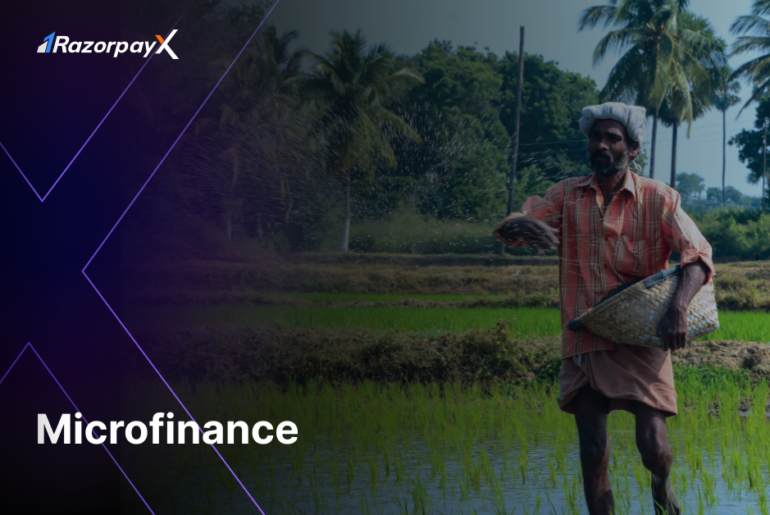What is Microfinance?
Microfinance is a branch of banking that provides credit in the form of small loans to low-income entities who may not be able to get funded otherwise.
It is considered not-for-profit, since the objective is to help impoverished individuals and groups create the means for employment and become self-sufficient.
Understanding the Importance of Finance
Money plays a very important role in mobilising people and communities. By providing funding for self-employment and entrepreneurship, microfinance institutions (MFIs) help people create a steady source of income and become financially independent.
While microfinance institutions provide the means for people to set up businesses, banks like ICICI and fintech solutions like RazorpayX provide banking solutions to help businesses manage their finances with ease.
How Does Microfinance Work?
Microfinance loans are given to people, businesses or groups that are impoverished and are not able to apply for regular loans due to a lack of income.
These groups are excluded from mainstream, traditional banking services since they might not be considered creditworthy or financially sound.
Microfinance loans are of significantly smaller amounts and therefore impose lesser interest rates and more flexible repayment schedules. For example, most of the loans offered by ESAF Microfinance range between Rs 2,000 to Rs 30,000.
Today, most banks and NBFCs that give out loans conduct assessments and analyses to determine if the person receiving the loan is creditworthy enough. CIBIL scores and other tests help determine the risk of giving out the loan.
An important factor in these tests is income. Impoverished entities do not have enough income to be considered creditworthy enough to qualify for a traditional loan.
Financial institutions that provide microfinance loans do so with the intention of helping these groups become financially independent and self-sufficient. They provide financial assistance with no intention of earning interest income – and also provide training programs, resources and support to help these entrepreneurs succeed.
General Terms of Microfinance Loans
All microfinance loans come with certain requirements and terms. As long as an individual fulfils these terms, they are eligible for the loan.
Having low or no income is one of the basic requirements to be eligible for a microfinance loan. Individuals from marginalized groups are eligible for these loans as well.
There are also specialized loan offerings, like agricultural microfinance loans and home improvement loans which have other specific requirements.
Since the recipients of these loans are too poor to offer traditional collateral as required by banks, microlenders often group several borrowers together to reduce risk due to default.
If a borrower is unable to repay a loan, he may seek help from other borrowers within this group or from the loan officer. The repayment terms for microfinance loans are much more flexible than traditional bank loans.
Benefits of Microfinance
Microfinance has proven benefits to both social and economic welfare. By empowering impoverished groups of people to earn and become financially independent, microfinance loans have helped unlock a whole section of the population to become productive members of the society.
Access to funding: Microfinance loans, with flexible repayment schedules and lower interest rates, allow immediate and easier access to funds for people who can’t afford or are not eligible for traditional loans.
This accessibility allows entire families to get out of a bad situation by funding self-employment or home improvement.
Economic benefits: Microfinance is an important factor in breaking the cycle of poverty. The main reason poor parents beget poor children is due to the fact that they cannot afford quality education, healthcare or other basic facilities.
Microfinance provides small, repayable loans to these families – repayment rates for microfinance loans have always been higher than traditional loans. Poor families can avail these loans, build self-employment opportunities or upskill, and then repay the small amount they had originally borrowed.
Building creditworthiness: Since microfinance loans offer small principals, lower interest rates and flexible repayment schedules, the repayment rates for these loans are very high – ranging between 90% to 98%.
By successfully repaying these small loans, poor families can build their creditworthiness and become eligible for a bigger loan in the future.
Microfinance in India
Microfinance loans have played a big role in mobilizing the weaker sections of society and improving the living conditions of the poorest.
Microfinance loans in India are offered by three major agencies: credit unions, NGOs and banks.
These agencies offer microfinance loans and financial assistance by organizing people into various groups:
Joint Liability Group: A Joint Liability Group (JLG) is an informal gathering comprising 4 to 10 members who come together to secure loans based on mutual guarantee. These loans are primarily intended for agricultural purposes or related activities. The JLG consists of farmers, rural workers, and tenants who share the responsibility for repaying the loan in a timely manner. The structure of the JLG is straightforward and does not require any complex financial administration.
Self Help Group: A Self Help Group SHG is a group of people with similar socio-economic backgrounds who come together for a limited period to pool resources into a collective fund. This fund is then borrowed by the group members for business requirements.
Members of an SHG do not need collateral to borrow from the pool and interest rates are kept very low. Banks partner with these SHGs as part of their commitment to enhance financial inclusion in rural areas.
Grameen Model Bank: The Grameen Bank operates on the principle of providing small loans, often referred to as microcredit, to the poor and underserved individuals, particularly in rural areas. The amounts offered as loans are small, and are offered to groups of about 5 individuals. These groups act as a guarantor for the members’ loans and thus ensure repayment.
History of Microfinance
The evolution of microfinance in India can be traced back to the 1970s and has since experienced significant growth and transformation.
The early years of microfinance in the decades after independence were focused on small-scale credit programs to address financial needs of marginalized groups, especially women.
Further introductions of innovative lending methods like Society for Elimination of Rural Poverty in Andhra Pradesh led microfinance to become a significant contributor to the expansion of microfinance.
By the 2000s, there were dedicated institutions and banks that offered microfinance loans and credit to the poor, like SKS Microfinance which would become one of the largest MFIs in the country. Regulation of the microfinance sector began to take shape as well, when the RBI stepped in with interest rate caps and other regulatory reforms.
These measures by the RBI aimed to strike a balance between protecting borrowers’ interests and ensuring the sustainability of microfinance institutions.
In recent years, microfinance in India has diversified and evolved. Traditional MFIs have expanded their offerings to include savings, insurance, and other financial services. Moreover, the emergence of technology-driven models and the rise of digital platforms have further facilitated access to microfinance and improved operational efficiencies.
Concerns of Microfinance
While microfinance has made significant strides in India, there are also several concerns associated with the sector.
- Indebtedness: One of the primary concerns is overindebtedness among microfinance borrowers. In some cases, borrowers may take loans from multiple lenders without the ability to repay them all, leading to a cycle of debt. This issue was particularly pronounced during the microfinance crisis in Andhra Pradesh in 2010.
- High Interest Rates: The interest rates charged by microfinance institutions (MFIs) have been a subject of debate. While MFIs argue that higher rates are necessary to cover the operational costs and risks associated with lending to the poor, critics contend that the rates can sometimes be exorbitant and may exploit vulnerable borrowers.
- Unregulated Informal Sector: Alongside formal MFIs, there is a large unregulated informal sector involved in microfinance activities. These informal lenders, often referred to as moneylenders or local lenders, may charge significantly high interest rates and engage in coercive collection practices, further exacerbating the issues of overindebtedness and financial exploitation.
- Lack of Transparency: Some microfinance institutions have faced criticism for their lack of transparency in operations, particularly regarding interest rates, fees, and loan terms. This lack of transparency makes it difficult for borrowers to make informed decisions and can lead to potential exploitation.
- Collection Practices: Coercive collection practices by certain MFIs have been reported, where aggressive tactics are employed to recover loan repayments. These practices can create undue stress and financial hardship for borrowers, undermining the positive impact of microfinance.
- Lack of Financial Literacy: Many microfinance borrowers have limited financial literacy, which can hinder their ability to make informed financial decisions, understand loan terms, and manage their finances effectively. It is crucial to provide adequate financial education and support to empower borrowers.
- Vulnerability to External Shocks: Microfinance borrowers, especially those engaged in agriculture or other weather-dependent activities, are susceptible to external shocks such as natural disasters, price fluctuations, and economic downturns. These shocks can significantly impact their ability to repay loans, making them more vulnerable to financial instability.
Addressing these concerns requires a multi-faceted approach involving regulations, responsible lending practices, consumer protection measures, financial literacy programs, and effective grievance redressal mechanisms.
Striking a balance between providing access to finance and safeguarding the interests of borrowers is crucial for the sustainable development of microfinance in India.
FAQs
What are the 3 types of microfinance?
Microcredit, microinsurance and microsavings are the 3 major types of microfinance. All 3 types work in unison to help provide financial assistance to the poor.
What is an example of microfinance?
Providing loans in small, easily repayable denominations to people so that they can be uplifted out of poor living conditions is an example of microfinance.
What is the point of microfinance?
Microfinance exists to help alleviate poverty by providing financial assistance to under served communities and people.





